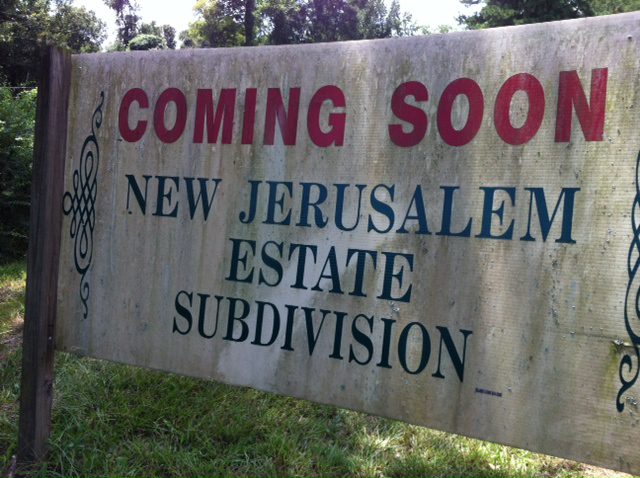Building The New Jerusalem
Judging by the mold on this sign, “soon” is a relative term. Then again, some of us have been waiting for the New Jerusalem for 2,000 years. Anyway, this sure does sound like something out of Walker Percy, duddenit? It’s just outside my town, where the Notre Dame architecture big Philip Bess paid a visit earlier this week with a group of his graduate students. They have been on a car tour of the American South, looking at architecture and urban design. I took them all to the venerated seafood shack Hot Tails, after which we returned to the Mothership and drank Bourbon. It was fun, and I was able successfully to beg Prof. Bess to sign my copy of his great book, “Till We Have Built Jerusalem: Architecture, Urbanism, and the Sacred.” From that book:
My conservative argument for urbanism … goes like this: The best life for human beings is the life of moral and intellectual excellence lived in community with others. All communities exist for the sake of some particular purpose its members commonly hold to be good. The singular and defining good of the city is that it is a community of communities, the purpose of which is to promote the very best life possible for its inhabitants. Good cities do precisely that. Thus, cities are in themselves a valuable and objective human good; in this view, politics — and even the most devoutly held political beliefs — are subservient to the good for which cities exist. This is true both historically and etymologically: “politics” both presumes and serves the good of the polis, the city.
Bess goes on to say, basically, that we make our towns and cities, and our towns and cities make us. He says political conservatives tend to be free market and libertarian, and don’t get New Urbanism, but cultural conservatives do. He proposed the following as an unofficial New Urbanist creed for cultural conservatives:
- We believe that individuals have both rights and obligations, that individual well-being requires good communities, and that liberty is not license.
- We believe that individuals should have as much freedom as justice allows.
- We affirm the political principle of subsidiarity, which holds that political decisions for the common good should be made at and through the smallest and most local institutional levels possible.
- We believe that the Urban Transect as a principle both promotes and accounts for the widest possible variety of free, just, and environmentally sustainable human settlements.
- We contend that traditional towns and urban neighborhoods demonstrate historically that they both support and are supported by the free exchange of material goods and ideas, including private property.
- We profess traditional urbanism in all its manifestations through the Urban Transect as the best way for human beings to organize and make human settlements.
- We fight for those who desire to live in compact, diverse, walkable communities, in the proximity of open landscape and a public realm of plazas, squares, and pedestrian-friendly streets.
- We fight for the legal right to build traditional towns and neighborhoods.
- We hope and believe that the merits of traditional towns and neighborhoods, manifest in various specific local forms, will cause traditional urbanism to once again someday prevail as a cultural norm.
- We work for the common good now, and for the common good of future generations.
One interesting thing about showing Philip and his students around my town is that even though it’s quite historic, and has plenty of beautiful old houses, it is not in the least traditionally urbanist. You cannot really walk to any stores. Plus, the strange geography of the town — the historic old part of town is built on a narrow ridge and there are steep hollows all over; the town’s footprint looks like a splat — works against the kind of physical community New Urbanists work towards. Nevertheless, there are some big tracts of land on the outskirts of town that could be developed as a New Urbanist community, if they were open to development at all. There’s also a long-disused retail strip downtown that could be torn down, and a mixed-use retail and residential building put up in its place. That would potentially seed the creation of a walkable downtown.
There are new subdivisions going in all over the parish, on former farmland, but nobody is (yet) trying to put in a New Urbanist-style development. I don’t really think most people around here consider walkability to cafes and shops to be a feature they desire. We live right now in the most walkable and lovely neighborhood in town, but the nearest place to get something to eat is about 3/4 of a mile away, and you have to use your car to get to the grocery store.


Subscribe for as little as $5/mo to start commenting on Rod’s blog.